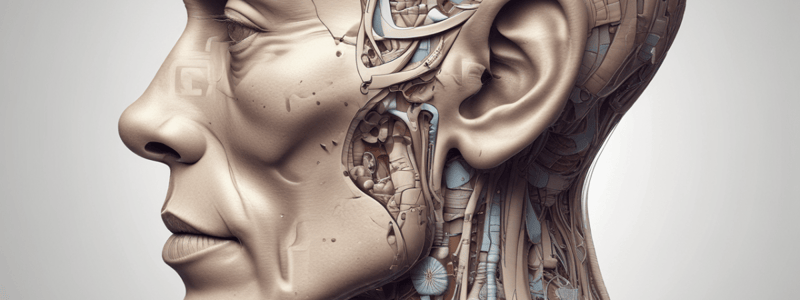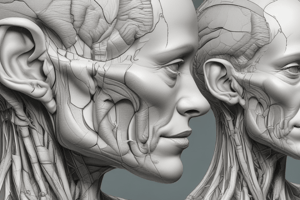Podcast
Questions and Answers
What is the primary function of the pinna in the external ear?
What is the primary function of the pinna in the external ear?
- To direct sound waves into the ear (correct)
- To separate air-filled and fluid-filled areas
- To regulate pressure in the inner ear
- To amplify sound waves
Which structures are located in the middle ear?
Which structures are located in the middle ear?
- Cochlea, vestibular apparatus, semicircular canals
- Pinna, ear canal, oval window
- Malleus, incus, stapes (correct)
- Tympanic membrane, Eustachian tube, round window
What role do the oval window and the round window play in the ear?
What role do the oval window and the round window play in the ear?
- They transmit sound to the tympanic membrane
- They regulate air pressure in the ear
- They separate the fluid-filled inner ear from the air-filled middle ear (correct)
- They amplify sound vibrations
Which of these structures is not typically associated with the inner ear?
Which of these structures is not typically associated with the inner ear?
What function does the Eustachian tube serve in the ear structure?
What function does the Eustachian tube serve in the ear structure?
Which structure in the middle ear assists in transmitting sound vibrations?
Which structure in the middle ear assists in transmitting sound vibrations?
The tympanic membrane is part of the inner ear.
The tympanic membrane is part of the inner ear.
What is the primary function of the semicircular canals in the inner ear?
What is the primary function of the semicircular canals in the inner ear?
The _____ directs sound waves into the ear.
The _____ directs sound waves into the ear.
Match the following ear structures with their descriptions:
Match the following ear structures with their descriptions:
Flashcards are hidden until you start studying
Study Notes
Ear Sections
- External Ear: The pinna captures and directs sound waves towards the ear canal for auditory processing.
- Middle Ear: Comprises the malleus, incus, and stapes; acts as a conduit between the air-filled middle ear and the fluid-filled inner ear through the oval and round windows.
- Inner Ear: Houses the cochlea for hearing and semicircular canals for balance; connects to the brain via the vestibulocochlear nerve, facilitating auditory and vestibular functions.
Structures within the Ear
- Ear Canal: Transmits sound waves from the external ear to the tympanic membrane.
- Tympanic Membrane: Also known as the eardrum, it vibrates in response to sound waves, initiating the auditory process.
- Round Window: Allows fluid displacement within the cochlea, essential for sound transmission.
- Internal Jugular Vein: Located near the ear structures, it plays a role in draining blood from the head and neck region.
- Eustachian Tube: Functions to equalize pressure between the middle ear and atmospheric pressure; in a normally collapsed state until needed.
Ear Sections
- External Ear: The pinna captures and directs sound waves towards the ear canal for auditory processing.
- Middle Ear: Comprises the malleus, incus, and stapes; acts as a conduit between the air-filled middle ear and the fluid-filled inner ear through the oval and round windows.
- Inner Ear: Houses the cochlea for hearing and semicircular canals for balance; connects to the brain via the vestibulocochlear nerve, facilitating auditory and vestibular functions.
Structures within the Ear
- Ear Canal: Transmits sound waves from the external ear to the tympanic membrane.
- Tympanic Membrane: Also known as the eardrum, it vibrates in response to sound waves, initiating the auditory process.
- Round Window: Allows fluid displacement within the cochlea, essential for sound transmission.
- Internal Jugular Vein: Located near the ear structures, it plays a role in draining blood from the head and neck region.
- Eustachian Tube: Functions to equalize pressure between the middle ear and atmospheric pressure; in a normally collapsed state until needed.
Studying That Suits You
Use AI to generate personalized quizzes and flashcards to suit your learning preferences.


